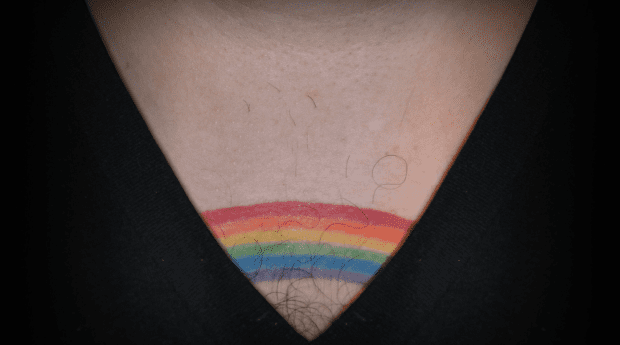Close your eyes, and imagine artist Vincent Chevalier’s blank hanky, tantalizingly inked on his ass cheek. This is butt one (see what we did there?) of the many highlights at Marked: Tattoos and Queer Identity, exhibiting at the Canadian Lesbian and Gay Archives (CLGA).
“Tattoos are an important aspect of queer identity because so often our queerness is invisible or hidden, by choice or by societal means, so a tattoo is a bold, brash statement,” says Christian Hernandez, curator of Marked.
The must-see exhibition is a collection of photographs that examine tattoos and their relationship with queer identity, sexuality and history.
Jordan Coulombe details the significance of his Saint Sebastian tattoo, which is based on a painting by Guido Reni — the martyred saint has become synonymous with queer iconography in art history. Coulombe also describes how he became pen pals with a tattoo artist in solitary confinement in Texas who taught him to construct tattoo equipment using scrap metal.
Ryan Conrad has “Silence=Death” inked across his chest as a permanent commemoration of AIDS activists from previous generations. In the accompanying text, Conrad outlines the backlash he has encountered on gay cruising apps, underlining the enduring stigma of HIV/AIDS.
“I wanted to mark on my body the connection between my generation of queer AIDS activists and those that came before me, those that raised so much hell and made a life possible for me as a fag in the midst of an HIV/AIDS epidemic,” Conrad explains in the text.
Hernandez also exhibits photographs of his own tattoos, including a crest of rainbow-coloured gummy bears. He says tattoos are an important aspect of queer activism and act as markers for visibility within the community.
“Historically, queer people have used and embraced visual markers as a way of identifying themselves as part of a community and to find each other. These have been things like, a certain flower worn on your lapel, a coloured bandana hanging behind your back pocket or a traditionally queer symbol worn on your backpack. These markers can also include things like language, being in certain places, mannerisms like limp wrists or countless other ways your queerness can be seen by someone else,” he says.
“Tattoos and queerness separately form part of the fabric that is our culture. Since they have both been historically stigmatized and hidden away, I think it is important to start to collect queer tattoos now in the best way we can. Tattoos are also a form of contemporary art, so why shouldn’t it be collected in the same way as we collect contemporary artists? Tattoos are also inherently difficult to collect, which in my mind means it is more important to collect them now since they are one of the most ephemeral forms of art in our world today.”
Marked: Tattoos and Queer Identity
Runs until Friday, May 29
CLGA, 34 Isabella St, Toronto
clga.ca

 Why you can trust Xtra
Why you can trust Xtra